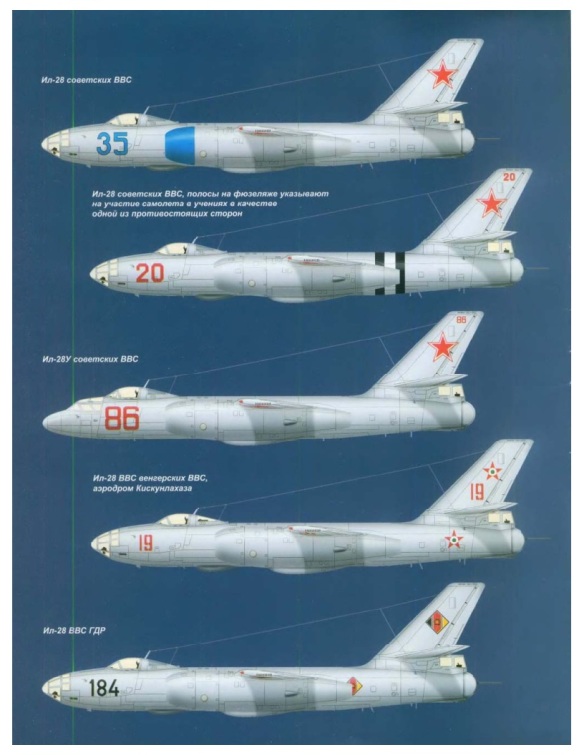Countries of origin: Russia and China
Type: Tactical bomber
Powerplants: II-28 – Two 26.5kN (5950lb) Klimov VK-1A turbojets.
Performance: II-28 – Max speed at 14,765ft 900km/h (485kt), max speed at sea level 800km/h (432kt), typical cruising speed at altitude 875km/h (472kt). Max initial rate of climb 2950ft/min. Service ceiling 40,350ft. Range at 32,810ft 2400km (1295nm), range at 3280ft 1135km (612nm).
Weights: II-28 – Empty equipped 11,890kg (28,415lb), max takeoff 21,200kg (46,738lb).
Dimensions: II-28 – Wing span without tip tanks 21.45m (70ft 5in), fuselage length 17.65m (57ft 11 in), height 6.70m (22ft 0in). Wing area 60.8m2 (654.4sq ft). Accommodation: Crew of three – pilot under fighter style canopy, bombardier/navigator in nose and rear gunner/radio operator in tail.
Armament: Two NR-23 23mm cannon in lower forward fuselage, two NR-23 cannon in rear turret and up to 3000kg (6615lb) of bombs, or two torpedoes in internal weapons bay.
History: The Harbin H-5 is China’s unlicenced built copy of the llyushin II-28 ‘Beagle’ light tactical jet bomber. llyushin first began design work on the II-28 in December 1947 as a private venture. The first of three prototypes, powered by two RollsRoyce Nenes (at the time the most powerful turbojets in the world and donated to the USSR by the UK Government during the late 1940s as ‘technical aid’), flew for the first time on July 8 1948. After competitive evaluation against Tupolev’s larger but similarly powered Tu-73 the II-28 was selected for production to meet a Russian Air Force need for a medium sized jet bomber. Several thousand ll-28s were built for the Soviet Air Force and various Warsaw Pact nations, with deliveries beginning in 1950. Over 500 were exported to China in the 1950s, while other II-28 operators included Egypt, Indonesia, Iraq, North Korea, North Vietnam, Syria and Yemen. Small numbers were also built in Czechoslovakia as the B-228. II-28 variants include the basic II-28 bomber, II-28T torpedo bomber, reconnaissance II-28R and the II-28U trainer with a second cockpit in the nose (forward of the standard cockpit). Several served through to the late 1980s as target tugs and ECM platforms. After Russia and China severed ties in the 1960s China began a program to build the II-28 unlicenced. The Harbin Aircraft Factory was responsible for reverse engineering the II-28 and consequently the first Chinese built ‘Beagle’, designated H-5, first flew on September 251966. H-5 production began the following year and continued into the 1980s (although late production was at a low rate primarily for attrition replacements). As many as 2000 H-5s may have been built (including HJ-5 two seaters and H-5R or HZ-5 reconnaissance platforms) for China’s Air Force and Navy. Several hundred still serve, despite their obsolescence. North Korea also operates Chinese ll-28s, with the export designation B-5.
Variants
Soviet Union variants
Note: Order of variants determined chronologically by production/development dates.
Il-28
Basic three-seat bomber version, powered by two VK-1 engines.
An Il-28U trainer of the Egyptian Air Force in 1981.
Il-28U
Unarmed training version fitted with new nose housing cockpit for instructor, while the trainee sat in the normal cockpit. First flown 18 March 1950.
Il-28R
Three-seat tactical photo reconnaissance version, with extra fuel in bomb bay and tip-tanks, and with one forward firing cannon removed. Fitted with revised undercarriage to deal with heavier weights. First flew 19 April 1950.
Il-28RTR
ELINT version of Il-28R.
Il-28REB
Electronic warfare, electronic jamming version, fitted with wingtip electronic pods, that were in the former wing tanks.
Il-28T
Torpedo bomber version for the Soviet Naval Aviation able to accommodate two small or one large torpedo (including RAT-52 rocket propelled torpedoes) in a lengthened weapons bay.
Il-28N
Nuclear bomber for the Soviet Air Force with modified bomb-bay and revised avionics. (N – Nositel – carrier, also known as Il-28A – Atomnyy – atomic).
Il-28P
Unarmed civil conversion for Aeroflot, used as jet conversion trainer and to carry high priority cargo (i.e. newspaper matrices to allow simultaneous printing of Pravda and Izvestia in Moscow, Sverdlovsk and Novosibirsk). Also designated Ilyushin Il-20.
Il-28S
Proposed swept-wing version with more powerful Klimov VK-5 engines. Unbuilt.
Il-28RM
Modified Il-28R with VK-5 engine. One prototype built plus two similarly converted bombers (which carried no special designation) but no production.
Il-28TM
Il-28T with VK-5. One converted, no production.
Il-28PL
High-speed anti-submarine conversion of Il-28 bomber or Il-28T torpedo bomber. Capable of carrying dropping sonobouys or acoustic homing torpedoes on direction of other anti-submarine assets.
Il-28Sh
Ground attack (Shturmovik) conversion of Il-28 with 12 underwing pylons for rocket pods. Small number converted which saw limited service.
Il-28ZA
Atmospheric sampling version.
Il-28M
Target drone conversion of Il-28. Also known as M-28.
Czechoslovakia variants
B-228
License-built standard Il-28s built by Avia in Czechoslovakia.
CB-228
License-built Il-28U trainers built by Avia in Czechoslovakia.
Chinese variants
H-5
(Hongzhaji – bomber) – Standard three-seat tactical bomber.
H-5A
Speculative designation of for nuclear capable H-5 variant.
HD-5
(Hongzhaji Dian – bomber/electronic reconnaissance) Chinese ECM jammer version.
HJ-5
(Hongzhaji Jiaolianji – bomber trainer) Chinese trainer version with similar layout to Il-28U.
HZ-5
(Hongzhaji Zhenchaji – bomber/reconnaissance) Tactical reconnaissnce aircraft. Fitted with underwing drop tanks instead of tip tanks of Il-28R.
B-5
Export designation of the H-5.
B-5R
Export version of HZ-5.
BT-5
Export version of the HJ-5.
H-5 Ying
(Ying – eagle) Avionics testbed for Xian JH-7 programme.
H-5B
Speculative designation for unflown H-5 testbed for WS-5 aft-fan engines.
